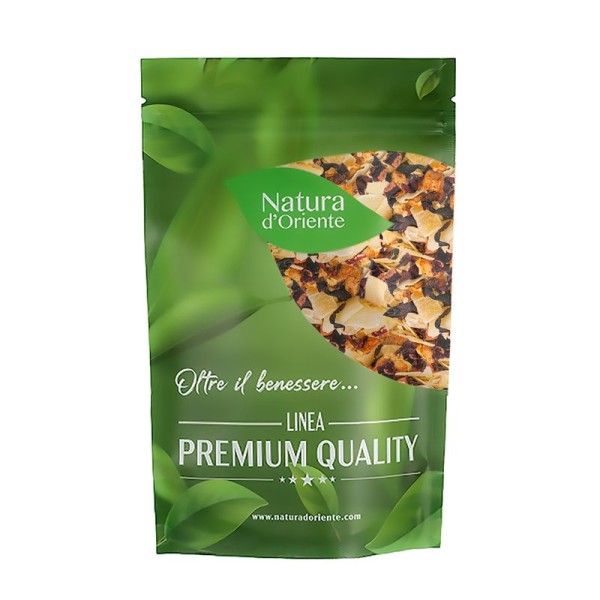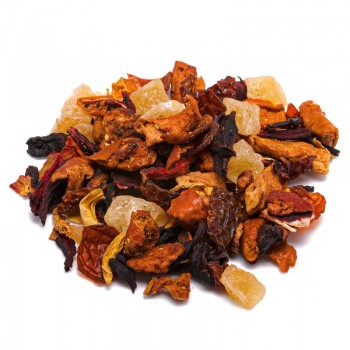The infusion of these ingredients acts both as a refreshing blend and to delight the palate with a sweet and rich flavour. Together, pineapple and coconut make up a drink of delicious quality, enhanced by other foods with sweet and exotic nuances. These tropical fruits act at the first sip, for the pleasure of savoring an infusion with a tropical flavour, light and regenerating at the same time. Excellent to taste or serve to guests, in any season.
Pineapple and coconut infusion: properties and benefits
In addition to its particular flavor, this blend creates an infusion with remarkable beneficial qualities. Together, the two fruits boast important purifying, diuretic and energizing properties. The combination of pineapple and coconut is rich in elements that are important for our body: potassium, magnesium, iron, copper and manganese; in addition to vitamins C, A, K and vitamins of group B. Thanks to the vitamin content, enhanced by other foods, the infusion presents itself as the perfect ally to strengthen the immune system, counteracting seasonal ailments. On a nutritional level, coconut acts as a tonic, which can help us in moments of weakness, thanks to the numerous vitamins. It facilitates the functions of the digestive system, avoiding stomach problems and digestive difficulties. Together with other substances contained in the infusion, such as apple and sc
orange barley, promotes the digestion of proteins and the absorption of nutrients, calming gastrointestinal irritations. As a diuretic, coconut is combined with pineapple to facilitate the expulsion of excess liquids and fight water retention. A useful element for the diuretic activity is given by pineapple bromelain, which helps to counteract swelling and fluids retained in the body. We know that toxins accumulate in our body due to unhealthy foods, polluted air, tobacco, alcohol, medicines, etc. This is why a purifying infusion represents a resource, not only by facilitating diuresis but also with the general detox action. Coconut is also rich in lauric acid, which has purifying and antioxidant properties, useful for counteracting the excessive growth of yeasts and bacteria in the body. Furthermore, the fats and amino acids contained in the coconut promote relaxation, good mood and relieve tension, in the face of nervousness problems. When combined with pineapple's doses of magnesium and potassium, these substances help muscle relaxation. Even pineapple, in fact, makes various minerals and antioxidants bioavailable, in addition to those mentioned: manganese, copper, vitamin C. The infusion of pineapple and coconut is recommended as a summer drink to counteract the loss of mineral salts and water, with its contribution of magnesium and potassium.
Origins and History of cultivation
The herbal tea blend features several natural elements that help body well-being, known for their properties for centuries. To create this infusion, several ingredients have been used: apple, pineapple, coconut, coconut oil, hibiscus, rosehip, orange peel. Some fruits come from tropical territories, such as hibiscus, pineapple and coconut, while others are known in our territories (orange, apple, rosehip).
The main ingredients are part of the "exotic" fruits known in the West after imports from the American continent. The coconut tree is a tropical tree, very difficult to grow in other climates. The origin of the plants is probably from the Indian and Malaysian territory, and they represent one of the most important crops for nutrition and economy. It usually bears fruit continuously for 60-70 years, thus making coconut production constant. The pulp of the coconut is rich in fat, in fact; it can be eaten fresh but can be easily dried, when it is not transformed into milk or coconut oil. The liquid from the nut is used for beverages, and is known as coconut water. A curiosity is that the coconut fruits float easily, and for this reason they are easily dispersed thanks to the ocean currents of the tropics.
The pineapple is also native to the tropical areas of the American continent. It was known among peoples, such as the Aztecs, who found the plant in the wild. Its shape made it famous on a decorative level, while the goodness of the fruit was particularly appreciated. After the colonization by the Spaniards, who discovered it and brought it to Europe, the pineapple spread throughout the rest of the world. Today, pineapple is grown throughout the tropical belt of the planet and is trova easily available everywhere, being a fruit that is easy to store and transport.
Plants and flowers
There are many components of the infusion, and the mix contains fruits and flowers of various origins.
The Ananas comosus plant belongs to the Bromeliaceae family. It is not very tall and grows well on drained soils, with excellent exposure to the sun. It bears fruit very slowly (even 2 years to reach full maturity). Its purple, pink or red flowers join the berries of the plant to form a single fruit, which resembles a pine cone in shape.
The coconut is the edible fruit of the coconut palm (Cocos nucifera), a tree in the palm family, Arecaceae. These are very prolific trees: a single coconut palm can produce around 100 coconuts a year. Each fruit, however, takes a year to ripen and become ovoid in shape. The thick fibrous shell surrounds the single seed, which is composed of pulp and liquid.
The Rose is a plant of the Rosaceae family, famous for its fragrant flowers. Most of the species derive from Asia, and decline in thousands of cultivars. The rose can come in the form of upright or climbing shrubs. Depending on the variety, the flowers change shape, size and color. The false fruit of the Rosa canina plant, called rosehip, looks similar to a red or orange berry. It contains achenes, the real fruits, and is a rich source of vitamin C. The orange tree is the Citrus sinensis L. belonging to the Rutaceae family and of Chinese origin. As a height it can reach 12 meters, with the famous white flowers and round and orange fruits, sweet oranges – distinct from bitter oranges. The orange probably represents a plant - hybrid, a cross between the pomelo and the mandarin, which occurred in the East.
The apple comes from the Malus domestica plant, belonging to the Rosaceae family. It is a tree native to Asia, now spread all over the planet for the nutritional value of its fruits. Apples differ in colors and varieties, used in human nutrition for thousands of years.
Nutritional values of pineapple and coconut infusion
The beneficial active ingredients of the infusion are antioxidants including vitamins C, A, and group B. There are substances such as bromelain and fats - including lauric acid . The ingredients are naturally endowed with minerals such as potassium manganese, magnesium, copper, phosphorus and iron.
How to use the ingredients in the infusion The infusion is obtained by placing about 3-5 grams of the pineapple mixture in a cup (250 ml) and coconut, with water at 100 °C. Leave to infuse for 10 to 12 minutes before drinking. Add honey or sugar, if desired.
Pineapple and coconut infusion: side effects and contraindications
There are no particular contraindications to taking the infusion, except for those who already have intolerances or allergies to individual ingredients. If consumed in excess, however, the infusion can cause stomach pain, a laxative effect up to diarrhoea, symptoms of nausea and headache. Caution, and attention to the ingredients, is advised for pregnant and breastfeeding women.











 No reward points for this product.
No reward points for this product.















![infuso frutti rossi [Natura d'Oriente]](https://www.naturadoriente.com/3542-home_default/infusion-of-red-fruits.jpg)